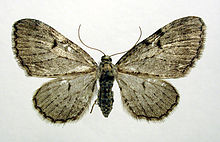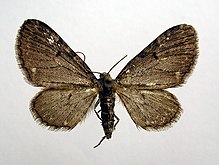Eupithecia actaeata
| Eupithecia actaeata | |
|---|---|

| |

| |
| Scientific classification | |
| Domain: | Eukaryota |
| Kingdom: | Animalia |
| Phylum: | Arthropoda |
| Class: | Insecta |
| Order: | Lepidoptera |
| Family: | Geometridae |
| Genus: | Eupithecia |
| Species: | E. actaeata
|
| Binomial name | |
| Eupithecia actaeata Walderdorff, 1869[1]
| |
| Synonyms | |
Eupithecia actaeata is a Eurasian species of moth of the family Geometridae.
Description
[edit]E. actaeata has a wingspan of 19–24 mm,[3] with broader wings than is typical for Eupithecia species.[2] Both wing pairs are grey,[2] brownish-grey,[3] or brown,[4] with somewhat paler hind- than forewings.[3][2]
Subspecies
[edit]- Eupithecia actaeata actaeata
- Eupithecia actaeata praenubilata Inoue, 1958
Distribution
[edit]Europe
[edit]Within Europe, E. actaeata is found France eastwards, where it is widely distributed in northern, central and eastern Europe,[3] and has only local distribution south of the Alps.[5]
Asia
[edit]In Asia, E. actaeata ranges from the southern Urals to Mongolia,[6] China (Qinghai and Shaanxi), Japan, the Russian Far East, Taiwan[3] and Korea.[2][4]
Habitat and host plants
[edit]E. actaeata has been found at altitudes from sea level up to 2000 m in Europe[3] and between 1600 and 3000 m in China.[2] It is found in forests with a presence of Actaea spicata (baneberry),[3][5] its main host plant. In north-western Europe, it is found predominantly in closed spruce forests.[7] In Asia, it has been found on another species of Actaea.[2] Other known host plants are Thalictrum aquilegiifolium and Thalictrum flavum.[3] Viburnum opulus has also been mentioned in scientific literature,[3] but might be erroneous.[8]
Life cycle
[edit]There are two generations per year with adults on wing from the end of May to August. Larvae can be found from June to September. It overwinters as a pupa.
References
[edit]- ^ Yu, Dicky Sick Ki. "Eupithecia actaeata Walderdorff 1869". Home of Ichneumonoidea. Taxapad. Archived from the original on March 25, 2016.
- ^ a b c d e f g h i Mironov, Vladimir; Galsworthy, Anthony Charles (1 November 2013). The Eupithecia of China: A Revision. BRILL. pp. 232–233. ISBN 978-90-04-25453-4. Retrieved 22 January 2023.
- ^ a b c d e f g h i Mironov, Vladimir (2003). Larentinae II: (Perizomini and Eupitheciini). Brill. pp. 174–175. ISBN 978-90-04-30863-3. Retrieved 22 January 2023.
- ^ a b Choi, Sei-Woong; Kim, Sung-Soo (30 April 2015). "New Records of Seven Eupithecia (Lepidoptera: Geometridae) from Korea". Animal Systematics, Evolution and Diversity. 31 (2): 132. doi:10.5635/ASED.2015.31.2.128. S2CID 86626630. Retrieved 22 January 2023.
- ^ a b Wagner, Wolfgang. "Eupithecia". European Lepidoptera and their ecology. Retrieved 22 January 2023.
- ^ Mironov, Vladimir; Galsworthy, Anthony Charles (5 March 2014). "A survey of Eupithecia Curtis, 1825 (Lepidoptera, Geometridae, Larentiinae) in Mongolia with descriptions of two new species". Zootaxa. 3774 (2): 101–130. doi:10.11646/zootaxa.3774.2.1. PMID 24871410.
- ^ Hydén, Nils (1990). "Baptria tibiale och Eupithecia actaeata (Lep., Geometridae) i Nordvästeuropa – utbredning, biologi, äggläggning och habitatval" [Baptria tibiale (Esper) and Eupithecia actaeata (Walderdorff) (Lep., Geometridae) in NW Europe – distribution, biology, oviposition and preferred habitats] (PDF). Entomologisk Tidskrift. 111 (1). Abstract.
- ^ Ellis, W.N. "Eupithecia actaeata – Plant Parasites of Europe". bladmineerders.nl. Retrieved 22 January 2023.
External links
[edit]
Text is available under the CC BY-SA 4.0 license; additional terms may apply.
Images, videos and audio are available under their respective licenses.
